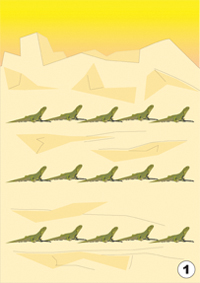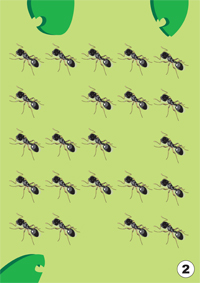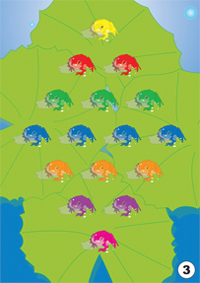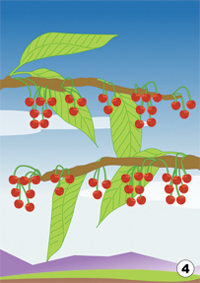|
|||||||||||||||||
|
|||||||||||||||||
%
responses 2009 ('05) |
|||||||||||||||||
y4 |
y8 |
||||||||||||||||
 |
1. How many lizards are there? | 15
|
87
(81) |
95
(97) |
|||||||||||||
| 2. How did you work out your answer? | |||||||||||||||||
| solution involved multiplication | (5 × 3
or 3 × 5) |
34
(35) |
82
(83) |
||||||||||||||
| solution involving addition | (5 + 5 + 5) | 43
(39) |
11
(12) |
||||||||||||||
| other sound approach not involving counting one by one | 5
(9) |
2
(0) |
|||||||||||||||
| any other response, including counting one by one/counting in twos | 18
(17) |
5
(5) |
|||||||||||||||
| Hand student picture 2. Allow time. | |||||||||||||||||
 |
3. Use a quick way for working out the number of ants. | 22 | 53
(49) |
75
(80) |
|||||||||||||
| 4. How did you work out your answer? | |||||||||||||||||
| solution involving multiplication | (5 × 2 + 3 × 4 or 5 × 5 – 3) | 8
(14) |
45
(51) |
||||||||||||||
| solution involving equivalent groupings | (e.g. 9 + 9 + 4) | 7 (8) | 8 (8) | ||||||||||||||
| solution involving just addition | (5 + 4 + 4 + 5 + 4) | 34 (27) | 21 (18) | ||||||||||||||
| other sound approach not involving counting one by one | 10 (5) | 5 (6) | |||||||||||||||
| any other response, including counting one by one/counting in twos | 41 (46) | 21 (17) | |||||||||||||||
| Hand student picture 3. Allow time. | |||||||||||||||||
 |
5. Use a quick way for working out the number of frogs. | 16 | 63 (55) | 74 (76) | |||||||||||||
| 6. How did you work out your answer? | |||||||||||||||||
| solution involving multiplication (4 × 4) | 1 (1) | 6 (8) | |||||||||||||||
| solution
involving recognising top and bottom have equivalent groupings (e.g. 6 + 4 + 6; 2 + 4 + 6 + 4) |
21 (23) | 47 (46) | |||||||||||||||
| solution involving row by row addition (4 + 4 + 4 + 4 or 1 + 2 + 3 + 4 + 3 + 2 + 1) | 29 (29) | 20 (22) | |||||||||||||||
| other sound approach not involving counting one by one | 10 (7) | 7 (6) | |||||||||||||||
| any other response, including counting one by one/counting in twos | 39 (40) | 20 (17) | |||||||||||||||
| Hand student picture 4. Allow time. | |||||||||||||||||
 |
7. Use a quick way for working out the number of cherries. | 50 | 29 (26) | 52 (48) | |||||||||||||
| 8. How did you work out your answer? | |||||||||||||||||
| solution involving multiplication | (7 × 5 + 5 × 3 or [3 + 7] × 5) | 6 (8) | 38 (36) | ||||||||||||||
| solution involving addition | (of 5 tens or of 5 sevens and 5 threes) | 21 (30) | 18 (23) | ||||||||||||||
| other sound approach not involving counting one by one | 21 (12) | 18 (18) | |||||||||||||||
| any other response, including counting one by one/counting in twos | 52 (50) | 26 (23) | |||||||||||||||
Total
score: |
11–12 |
4 (0) | 30 (28) | ||||||||||||||
| 9–10 | 11 (16) | 27 (33) | |||||||||||||||
| 7–8 | 25 (18) | 19 (19) | |||||||||||||||
| 4–6 | 37 (44) | 18 (16) | |||||||||||||||
| 0–3 | 23 (22) | 6
(4) |
|||||||||||||||
| Subgroup Analysis [Click on charts to enlarge] : |
| Commentary: |
| There
was little change in performance at both year levels from 2005 to 2009.
Year 4 Pasifika students performed similarly to Pakeha students. |

